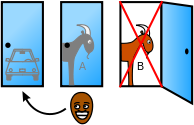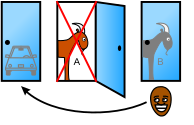Monty Hall problem
The Monty Hall problem is a famous problem in probability (chance). The problem is based on a television game show from the United States, Let's Make a Deal. It is named for the host of this show, Monty Hall.
In the problem, there are three doors. A car (prize of high value) is behind one door and goats (booby prizes of low value) behind the other two doors. First, the player chooses a door but does not open it. Then the host, who has knowledge of what is behind every door, opens a different door which they are certain has a goat behind it (opening either door with equal chances if the car is behind the player's door). Last, the host lets the player choose whether to keep what is behind the first door or to change choices to the third door (the one the host did not open). The rules of the problem are that the host has to open a door with a goat behind and has to let the player switch. The question is whether changing choices increases the chances of getting the car.
The chances of the car being behind the two doors that are still closed seem equal, so most people say changing choices does not increase the chances of getting the car. The true answer is that changing choices increases the chances of getting the car from 1/3 (one out of three) to 2/3 (two out of three).
That comes from the fact that the player, by choosing one door out of three, has a one chance in three of selecting the door with the car. The chance of the car being somewhere behind the other two doors is two out of three. So to improve their chance of winning a car, the player if given the choice, should swap their one door for the other two doors right away. But wait! The host then tries to confuse the player by opening one of their own goat doors. That changes nothing, remember that the player is still swapping their one door for the other two doors (even though one of them has been opened).
These are the options:
1. (Lose): If the player picks the car, then the host will show a goat. Then if the player changes their choice, they will get a goat .
2. (Win) : If the player picks a goat, then the host will show the other goat. Then if the player changes their choice, they will get a car.
3. (Win) : If the player picks the other goat, then the host will show the first goat. Then if the player changes their choice, they will get a car.
So, it is true that if the player changes (switches) then the player will win a car two times out of three.





